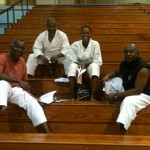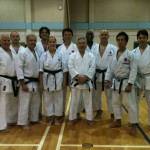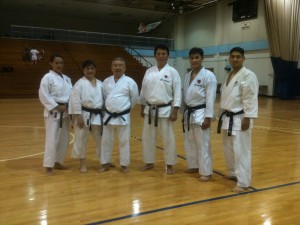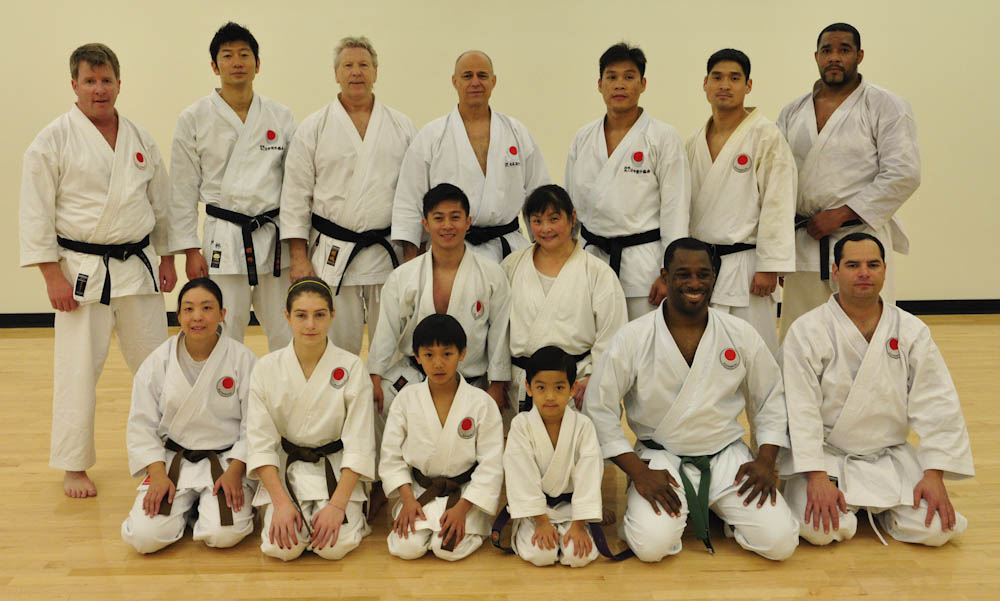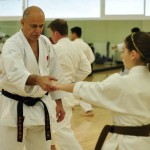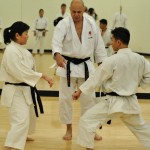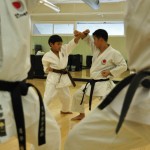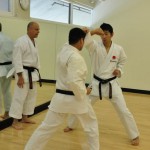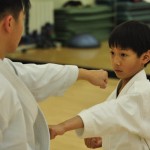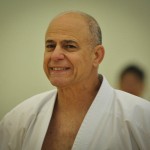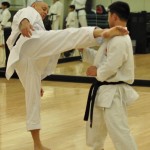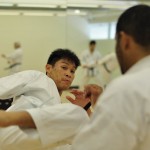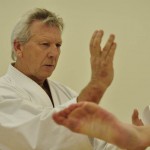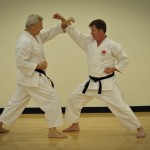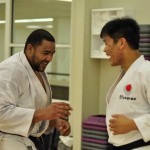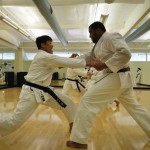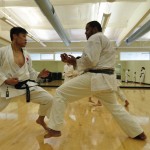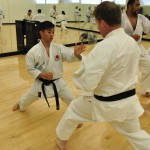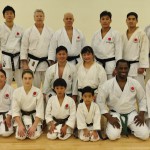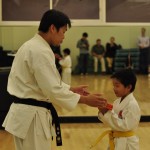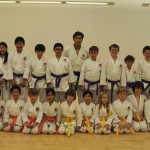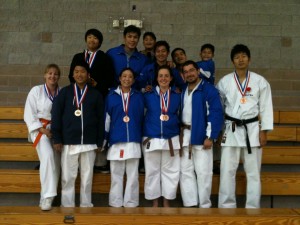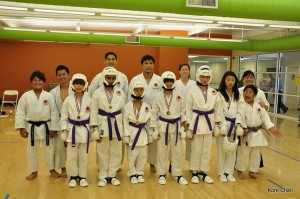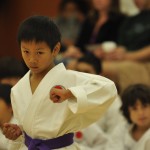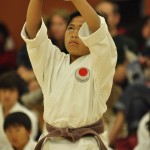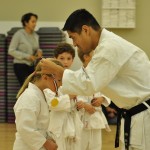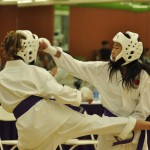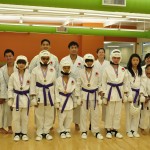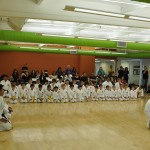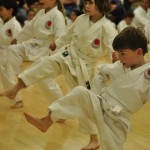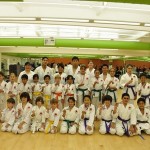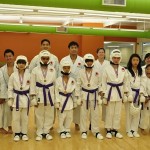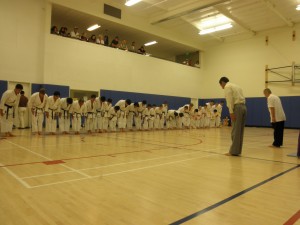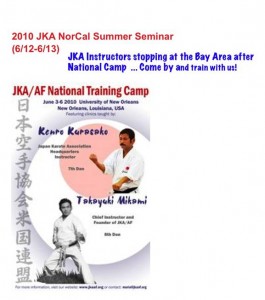Sensei Shiina returns to the US in Miami, FL for an encore awesome karate camp! Come for the week, or come for the weekend – you will not regret it! Only U$150 (flat rate) … what a deal! Train with Miami Shotokan Karate Club, with Sensei Jose Ferrand who is hosting and bringing to us “world class” karate instruction. Don’t miss out on this exciting event.
Here is the information:
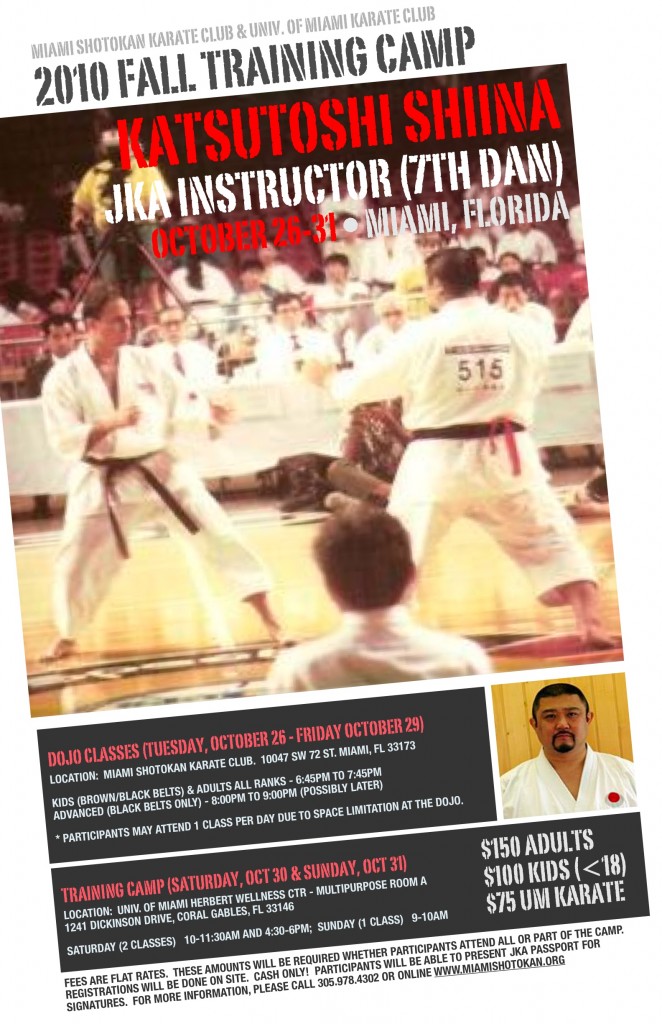
Day 1 @ Miami Shotokan Dojo (10/26)
Sensei Shiina arrives a little early before the first class with his wife Mrs. Shiina. You truly feel his presence, heartfelt friendliness and a sense of familiarity to be back at the Miami dojo. His enthusiasm and spirit is infectious … you feel compelled to respond in kind, or more accurately a “knee-jerk” reaction to his deep bellowing count! He tried to set everyone at ease, this being the first day- he encouraged students to ask more questions and relax, to warm up for the rest of the week.

(ALL RANKS CLASS) He began with our typical JKA ground rules, emphasizing the importance of straight lines, good karate etiquette and strong spirit while in training. The first class had a mixture of brown/black belts with a sprinkling of color belts and kids, although lots of focus on Basics – it was plenty challenging. Sensei Shiina asked everyone to be mindful with our punches – make sure to hit with the first 2 knuckles (demonstrating on makiwara), direct our techniques toward our center lifeline and deliver punches with more power using hip vibration. DRILL: Step back rising block reverse punch, step forward oizuki face punch. Then with partner, one side oizuki, the other side steps back age-uke (not toe to toe, opp side) and reverse punch. Progress with more speed. Rotate partners. Sensei called out the 3 techniques in this lesson: (1) Rising block with hips 45 degree; (2) Reverse punch rotating hips to front forward and (3) Step in punch with hip vibration to generate power and end with body forward and hips to front. Point – Gedan berai, hips although 45 degree, the joint is still closed. He had the black belts in the class in deep front stance, slowly tracking hips sideways rotating to hips front faced while concentrating on “closed” joint. DRILL: zig-zag step in punch to targets down the line… many rounds with more speed and more focus. Then he ended the class with Heian Shodan with the same feeling and adrenalin as the zig-zag drill and SPEED!
(ADVANCED CLASS) Warm up with kicking. Standing with feet together, right leg front kick (focus on lifting knee) snap back to front stance with right leg back. Next, right leg front kick again (focus on extending hip joint forward) snap back to standing position. Repeat with left leg. Point – lifting knee focus for short distance and extending hip focus on longer distance. DRILL: with partner standing and kicking in place. Other person gedan berai shifting tai sabaki reverse punch. Left hand blocking right leg kick and tai sabaki to the other side right hand blocking left leg kick. Repeat with speed. DRILL: in groups of 3, center person at kamae, steps in punch to ‘front target’ then quickly steps back turning to ‘back target’ to step in punch. Repeat with speed and stretching the distance for the oizuki. DRILL: in groups of 3 at a triangle formation, center person steps in punch to ‘right target’ then back to step in punch toward ‘left target’. Repeat with speed. DRILL: same group of 3 in same formation, center person steps in punch 2 times to each target before moving to other side. Now the target age-uke reverse punch to block and counter on each oizuki. Point – quick step back on transition for each oizuki. DRILL: add on an additional ‘front target. A series of oizuki to ‘right target’ and ‘left target’ (6 times) then gedan to the front for a series of 5 oizuki face, step back age-uke. The target reacts with step back age-uke and step forward oizuki face. The challenge is how to execute on this drill in 7 seconds – impossible! Well that is the benchmark for Japan National Team (of which Shiina Sensei is the Coach for next year’s JKA Funokoshi Cup in Bangkok, Thailand). We stretched a little and warmed down the class with Kata (Hangetsu, starting with left side then right side). Shiina Sensei says that in karate, we should workout on both the right and left side (balance). He also paused to reflect on JKA’s Sugiura Sensei’s writing (framed on Miami Shotokan’s wall), how when we train, our “body” is kamae, on alert, pumping with high energy and readiness while our “heart” is calm, thoughtful, controlled and deliberate. This in contrast when we perform Hangetsu Kata which is the opposite where our ‘body’ is slow, controlled and deliberate while the ‘heart’ on the inside is beating fast on high alert and anticipation.

Day 2 @ Miami Shotokan Dojo (10/27)
(ALL RANKS CLASS) Review basic blocking techniques – soto-uke, uchi-uke from standing position, then stepping forward. Point – attention on the course of the blocking beginning from hip down position. Transition to review the blocks in Bassai-Dai. Make sure of proper body contraction and expansion of chest in the beginning series of blocks. Work on slow-mo kata (which is much harder training) then explode to fast and strong. DRILL: from standing position left leg step forward soto-uke, in place uchi-uke, kizami-zuki, kunge gyaku-zuki (maximum reach). Repeat for other side. With partner, modify kizami-zuki to age-uke with a deep reverse punch responding to attacking side’s 4 punches, chudan, chudan, jodan, jodan. Sensei reviews bunkai for Heian Nidan with color belts and Bassai-Dai with advanced belts.
(ADVANCED CLASS) I should have guessed that it would be an intense class when Sensei Shiina took time to sufficiently “warm us up” in the beginning of class. From seiza – knee kicks; from standing – back fist to the back, reverse punch back to standing facing front; a series of tai-sabaki blocks with reverse punch on both sides – age-uke, uchi-uke and lastly gedan-berai with kekomi counter. With SPEED. In groups of 4 lines – he checked our brown belt katas (Bassai-Dai, Kanku Dai, Empi and Jion). He pointed out the importance of pivoting on the heel; expansion and contraction of chest and back muscles; and how to set up and explain bunkai for kata. A water break to rest up before donning our sparring gloves. Then, it is a series of “killer” zig-zag drills! LESSONS: (1) we spent a considerable amount of time learning how to ‘set-up’ these zig-zag formations – targets at 45 degree facing, staggering targets at varying strides not just uniform so we make adjustments for distance during the drill; (2) team spirit – the lead in the group charged with keeping the energy and spirits high (keep count, cheer, encouraging … ). I must admit, it did not come natural for us in a drill, at a class situation to feel that kinship/camaraderie. It took Sensei much bellowing in your face “you must talking to your team” to get us hyped up sufficiently to his satisfaction. Hmmm… perhaps we got a glimpse of how they ingrained the envious ‘team spirit’ we see in the japanese team – it is part of their class training. DRILL: kizami-zuki, gyaku-zuki (only 2 slides to reach target) down the line; then with targets slightly further apart – 4 punches 2 steps (kizami-zuki, gyaku-zuki, gyaku-zuki, gyaku-zuki) down the line. Then, he separated the group under 49 years – higher intensity. Next, 40 and under – add more intensity. Building up to the “uber” DRILL: in pairs, one go through the rigor down the zig-zag formation while the other wait at the last tollgate where they meet for an explosion of full blown KUMITE! Unbridled, not tournament style, non-stop kumite until Sensei calls for “Yame”. A couple more rounds and then a final add-on to DRILL: after “yame”, immediately ready into 2-wazari tournament style points to complete.
Day 3 @ Miami Shotokan Dojo (10/28)
(ALL RANKS CLASS) Standing position, step back down block gyaku-zuki, back to starting. Repeat other side. Next, switch in place, down block gyaku-zuki. With speed. DRILL: variations of one-step sparring – with partner, one side step in oizuki, other side step back age-uke (toe-to-toe), reverse punch. The oizuki person now counters on the reverse punch with tai-sabaki, (1) down block gyaku-zuki. Repeat with speed, 3x for each side; (2) empi elbow block, spinning 180 degree, empi with the other arm to the back of partner. DRILL: In groups of 3 (an “L” formation), 1st person face each other – do the previous (1) drill. Attacker continues at 90 degree turn to face next target – do the (2) drill. Note, targets starts from standing position step back rising block reverse punch. DRILL: In groups of 4 (a square formation), face 1st target (1) down block gyaku zuki, 90 degree turn face 2nd target (2) down block mawashi-geri jodan, and another 90 degree turn to face 3rd target (3) spinning empi to the body. DRILL: In groups of 3 (an “L” formation), face first target (1) empi, 90 degree turn to face 2nd target for (2) full blown kumite. Kumite agility move left, move right, counter. Sensei reviewed Heian Sandan with color belts and Jion with advanced belts.
(ADVANCED CLASS) We began class rather unconventional – Sensei had us all lying face down on the floor. The exercise was to flip your self up and roll in the air to land back face down on the floor again. Needless to say, I ended up rolling over on my right then rolling to my left. Not really sure what that was all about but I suppose it got us down on the floor. The next thing we were doing was the 2 round house kick from the floor in Unsu Kata. DRILL: with partner, one side steps in for an attack while the other brings knee/leg up to jam foot into the attacker’s body, attacker steps back and steps forward again for an oizuki face punch. The partner drops to the floor and round house kick to the body and flip on side to round house again to the body when the attacker switches stance to oizuki face punch again. We reviewed Unsu Kata next. Water break, then hand pads. DRILL: In groups of 3 (a mirror “L” formation), the person in the center with left foot forward faces the top of the “L” – punch gyaku-zuki chudan and kizami-zuki jodan; at the same time the partner also with right food forward initiates and counts




